Matter and Antimatter – An Explosive Couple! (Particle Physics Series – Episode 4B)
Did you know that the energy contained in a glass of water could wipe out all life on Earth?
Yet, to unlock this energy, the water would need to meet the same amount of anti-water…so don 't worry. Antimatter is very rare in our surroundings: you pouring yourself a fresh drink will not bring Armageddon to our blue planet ;-)
In this article, we will show how Antimatter forms from energy, and how, reversely, it can annihilate with matter in a burst of energy. We will perform some fun calculations using Einstein’s famous equation E = mc2 and show how insignificant objects conceal astronomical amounts of energy.
1/ Table of content and preliminary notes
To enjoy this article, you do not need a deep prior knowledge in particle physics. However, to fully grasp all concepts presented, it may be a good idea to brush up. I added 2 appendices at the end of this paper to familiarize yourself with the basics.
I also recommend you read Episode 4A, “Antimatter, the mirror world”. This episode presents the fundamentals about antimatter.
Episode 4 of the Particle Physics Series explores various facets of anti-matter through 5 distinct articles.
- Episode 1 : How antimatter was discovered. Description of antiparticles and composite anti-particles.
- Episode 2 (this one): Interaction of matter and anti-matter (pair production and annihilation). Meeting an anti-you and destroying the world.
- Episode 3: The birth of matter and antimatter in the universe. Matter/antimatter asymmetry and The CPT theorem.
- Episode 4: Detecting antimatter in our universe. Are there anti-planets, anti-stars and anti-galaxies?
- Episode 5: Could we be the neighbors of an antimatter universe? (Context: multiverse of level 1).
Now, let’s dive in!
2/ The energy concealed in matter
As we discussed in a previous article about the mass of matter particles, mass can be converted into energy, and energy into mass, as expressed by Einstein’s famous equation E = mc2.
For example, during a fission reaction of Uranium like the one below, the mass of the products (The Baryium and Krypton isotopes and 3 neutrons) is less than that of the Uranium reactant. The missing mass or “mass deficit”, is converted into energy via E = mc2.
However, only a tiny fraction of the original mass is converted, less than 0,1%!
Yet, that tiny fraction is sufficient to power nuclear power stations… or bring devastation.
The fraction of mass converted into energy is larger in a fusion reaction, like the one that powers our sun (4 protons convert into one helium nuclei, 2 positrons, 2 neutrinos and 2 gamma photons). The energy released shows up as the kinetic energy of the lighter particles produced.
Although the fusion reaction is energetically more efficient than fission, it converts less than 1% of the mass of the reactants. That means that the energy released by nuclear fusion (which in our perspective is huge) taps in just a tiny fraction of what could be available from the total mass of the reactants.
Fusion is what powers stars, yet it only uses a very small fraction of the energy available from mass. Just imagine the tremendous amount of energy that would be released if all of the mass of the reactants was converted into energy.
Well, this is what occurs when a particle meets its antiparticle. They annihilate completely and their mass is fully converted into energy (under the form of photons). This is called a matter-antimatter pair annihilation.
3/ matter-antimatter pair annihilation and production
A typical matter-antimatter pair annihilation is that of an electron and a positron. The products of that reaction are two photons. Each of the photons carries half of the energy released from the mass conversion.
The mass of an electron and that of a positron are rigorously the same: 9.109 x 10-31 Kg. The speed of light c is 2.998 x 108 m/s. Let’s apply Einstein’s equation:
As there are two photons produced, each photon will inherit from half that energy (8.187 x 10-14 J). That doesn’t seem much, but relatively to the scale of an electron, it is huge. Particle physicists prefer using the more convenient Mega-ElectronVolt unit (1 Mev = 1.602 x 10-13 J). In such unit, the energy of the photons would be:
Pair annihilation is a particle physics reaction. It follows the standard model’s symmetries, hence obeys it conservation laws. Important properties need to be conserved as for example the charge (Q), the baryon number (B), the momentum etc. This is why such annihilation can only occur between a particle and its antiparticle. For example:
- Photons (Q = 0) have no charge so an electron (Q = -1) must react with a positively charged particle (Q=+1).
- Photons are not leptons (Le = 0), so an electron (Le = 1) must react with an antilepton of electronic flavor (Le = -1), to conserve the electronic lepton number.
The only particle with Q = +1 and Le = -1 is the positron (also called anti-electron).
Another quantity that needs to be conserved in all reactions is momentum. This is why the energy released is shared between two photons instead of a single one.
The reversal is also true. A very energetic photon can convert into matter (for example below, a high energy gamma photon converts its energy into an up quark and an anti-up quark.
In order to conserve momentum, the photon has to come close to a nucleus on which it can ricochet some of its momentum when forming a particle-antiparticle pair. Again quantum numbers like charge, baryon number, lepton number and some others must be conserved implying that if a particle is produced, its antiparticle is produced too. One can only be formed with the other. This is a fundamental symmetry in particle physics.
4/ Matter and Antimatter, an explosive couple!
Let’s imagine now that we have a glass containing 25cl of water (0.25Kg). Let’s pour this water in a 50cl bottle. Now let’s imagine that we could add to the bottle, the same amount of anti-water, a molecule composed of 2 anti-protons linked to 1 anti-oxygen, all three hanging out inside a cloud of positrons.
What do you think would happen?
Immediate annihilation of all the water and anti-water molecules (in total 0,5 Kg)! How large would the corresponding explosion be? Let’s have some fun with Einstein’s formula:
The energy released would be of about 45000 TJ (1 TJ or Tera-Joule is 1 Trillion joules). For comparison, the atomic bomb released on Hiroshima released 75 TJ.
The glass of water that you are about to drink, if it were to annihilate right now, would release the equivalent of 600 Hiroshima bombs and probably wipe out the whole region you are living in… The ash distributed by the winds would cause a nuclear winter around the globe, bringing life on Earth close to extinction… Quite an expensive drink, don’t you think?
What about if you met your anti-you?
Assuming a mass of 70Kg,
Well you would immediately disintegrate by liberating close to 300 times as much energy. That’s nearly 200000 Hiroshima bombs…
Feel like blowing up the world? Yes, you have it in you! ;-)
Let’s think bigger...
What if the Earth, our planet, met an anti-Earth (mass of Earth is 6 x 1024 Kg)?
The core of the explosion would reach temperatures hundreds of times larger than that at the center of the sun. The explosion itself would probably expand beyond the Kuiper belt, ravaging the whole solar system on its way, evaporating Jupiter and scorching Pluto under thousands of degrees. It would probably be one the brightest event of the history of our galaxy…
Such an event would also have a specific signature in the energy of the photons produced. We will discuss the observational studies on the subject in a future episode.
Not having observed any such event in our close universe is kind of reassuring. It tells us that there are only extremely small quantities of antimatter in the known universe, and such cataclysmic explosions are very unlikely to occur.
But… wait a second,
You just told me that antimatter annihilation or pair creation should respect conservation laws…so shouldn’t there be as much matter as antimatter in the universe?
In the next episode we will explore this question in detail. First, we will describe how matter and antimatter came to be during the birth of the universe. Then, we will dive deep into the heart of this mystery by introducing a critical concept in particle physics called the CPT theorem.
So, stay tuned!
Appendix 1 – Elementary Particles
Let’s have a look at the list of elementary particles listed by the standard model.
There are 12 particles of matter, called fermions. Fermions form matter as we know it. Actually, in our day to day life, only the first column of particles forms matter (up quark, down quark, electron). There is also this cute particle, the neutrino that is also involved with matter, yet indirectly. I will post in episode 3E a video about this cute little baby.
The particles of the two other columns are produced in conditions of high energy, for example, in particle accelerators, during naturally-occurring energetic collisions between particles like cosmic rays hitting our atmosphere, and other extremely energetic phenomena. In the conditions we live in, particles of the second and third column are not stable.  
And the reason why there are 3 columns and not 2, or 4 , or 67? … well.. we have no clue… there is a Nobel prize to win here… Want to give it a shot?
The standard model lists also particles of force called bosons. By being exchanged between particles, bosons mediate the forces that can occur between these particles, hence shape their interaction.
And finally, the Higgs Boson, predicted 50 years ago, but discovered only this decade, is a special type of boson . For example, one of its roles in the standard model is to make a property emerge for many of the elementary particles: mass. Yes, it gives them mass. If you want to know more, great content about the Higgs have been recently published on Seemit by @lemouth (Click here to consult this paper)
Appendix 2 – Building Protons and Neutrons out of Quarks
We know that the nucleus of an atom is composed of protons and neutrons bound together by the strong nuclear force. Both protons and neutrons are nucleons, which themselves are member of a larger family called the baryons.
Baryons are composite particle formed from 3 quarks. Mesons are also composite particles, but these are formed from 2 quarks. .
All particles that are formed with quarks are called hadrons (that includes therefore baryons and mesons).
Quarks have “quantum numbers” associated to them. These numbers can only take discrete values. Two important ones are the electric charge and the Baryon number.
For example both the up quark and the down quark have a baryon number of +1/3, and their charges are +2/3 and -1/3 respectively.
Grouping 2 up quarks and 1 down quark will form a particle that has a baryon number, B = +1/3 +1 /3 + 1/3 = +1, and charge of Q = +2/3 + 2/3 – 1/3 = +1. B = +1, so it is a Baryon. Q = +1 so it also has a positive charge. This composite particle is a proton!
Grouping 1 up quark and 2 down quarks will form a baryon with B = +1 and Q = 0. This one is a Neutron.
The 'Particle Physics' series is aimed at providing an introduction to the world of small scale physics to non-scientists and high school students preparing for their high school exams.
Previous episodes:
- Elementary particles, the building block of reality (Particle Physics Series – Episode 1)
- Composite particles: let’s play Lego! (Particle Physics Series – Episode 2)
- Elementary fermions: the particles of matter… (Particle Physics Series – Episode 3A)
- Where does the mass of hadrons come from? (Particle Physics Series – Episode 3B)
- Let quarks be free! (Particle Physics Series – Episode 3C)
- Antimatter, The Mirror World (Particle Physics Series – Episode 4A)
Can't wait to know more?
If you can't wait to dive deep into the antimatter world, there are already some excellent articles on Steemit written by a professional particle physicist, @lemouth.
- Live from CERN - What does antimatter say when it falls?
- Live from CERN - Measuring antimatter properties with hybrid matter/antimatter atoms (without destroying the world)
- Live from CERN - ELENA is so beautiful that antimatter gets slow
- Antimatter strikes back: the CPT symmetry and the revenge of the antiproton magnetic moment at BASE (CERN)
Sources, references and to dig deeper:
- https://en.wikipedia.org/wiki/Nuclear_weapon_yield
- https://en.wikipedia.org/wiki/Antimatter
- Small scale Physics - Part 1 and 2 (booklet I wrote for my students)
- Book: Physics for the IB diploma (K.A. Tsokos, Cambridge edition)
- Book: L’anti-matiere (Gabriel Chardin)
Image credits:
- Image of Nuclear explosion by National Nuclear Security Administration / Nevada Site Office (link)
- Image of the Sun by NASA / SDO (AIA) (link)
- Image E=mc2 by Danielle Pellati (link)
- Explosion used in water + anti-water illustration found on MaxPizel (public domain, link)
- Woman used in you + anti-you illustration found on pngplay.com (link)
- All other pictures and visual elements are free for use commercially and were found either on Pixabay
- All illustrations, diagrams and friezes put together by @muphy.
Hi,
I’m @muphy (see intro post),
My life revolves around music production, teaching sciences, and discovery through travel.
You enjoyed that post? Resteem and Upvote!
You are interested in these topics? Follow me!
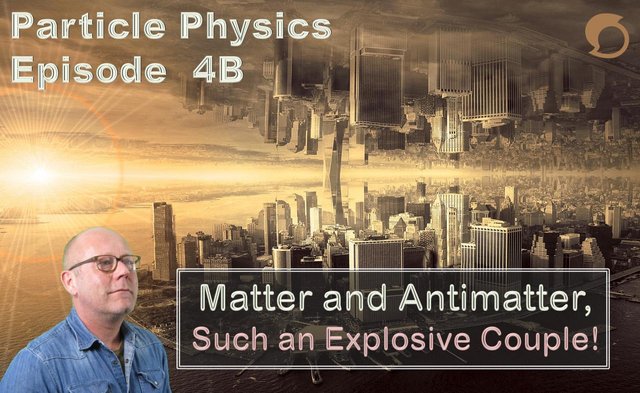


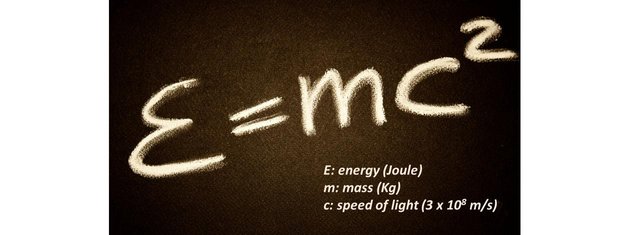



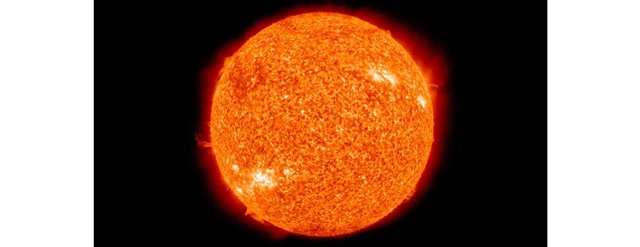










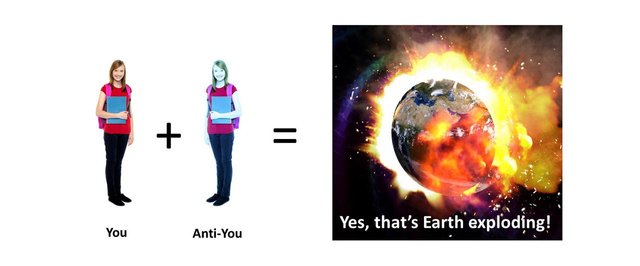


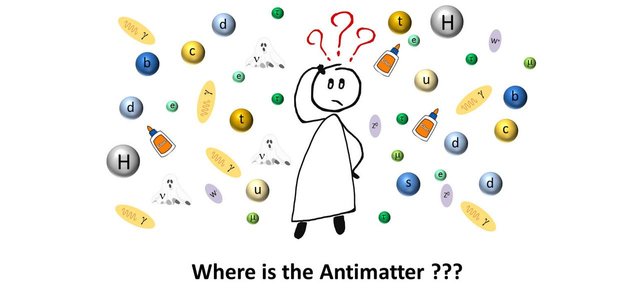

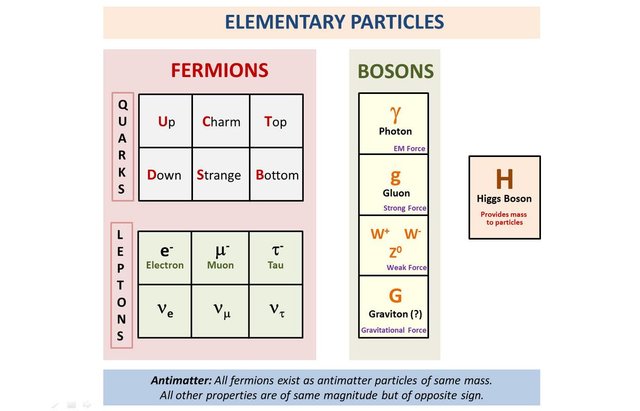

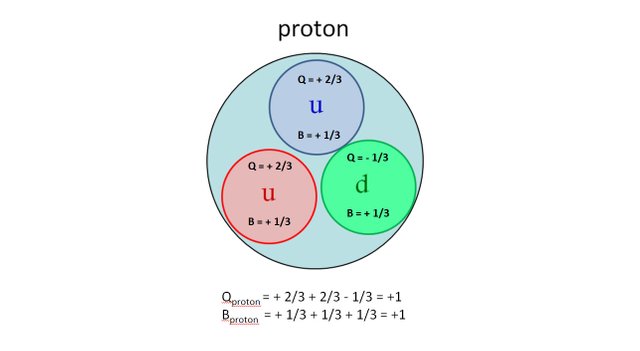

Being A SteemStem Member
Great post. Upvoted and followed.
I recently watched a FermiLab youtube video on antimatter and why it is missing from the universe.
A better question is why didn't matter & antimatter just annihilate each other with 100% completion.
Would love to hear your thoughts on this.
Yet, particle physicist are not in front of a white page here. There are some particle physics reactions that do not seem to be perfectly "symmetric", i.e. that appear to favor slightly matter over antimatter. These reactions are under deep study .
I am currently reflecting on the next episode, that should enlighten you (yes a full episode on this question :-)! I will discuss the first instants of the universe, where matter and antimatter were formed.
Then, I will introduce a really important pillar in physics: the CPT theorem, and briefly mention some of the reactions that appear to violate it in favor of matter.
So stay tuned!
We are still working hard to answer this question. This is one hot topic in particle physics and there is for the moment no answer to it (but plenty of different options are available explaining why matter is dominating today).
Hi, thanks for a very interesting article.
I have 2 questions.
Does the photon itself have its anti-particle?
If our universe was made mostly of anti-matter, instead of matter, would the laws of physics be any different?
Thanks!
Yes, the photon has an anti-particle... itself :-)
That is a very interesting question.
My gut instinct would be to say yes: If they were identical for matter and antimatter, that would mean a perfect symmetry between matter and antimatter, which is obviously not observed.
However, if you imagine that all matter in the universe changed to antimatter in an instant, I am not sure you would notice a difference in your daily life. The consequence of differences in physics laws would be unnoticeable on a human timescale. Only over an extensive amount of time, maybe eons, the slight assymetry would maybe show up as a gradual increase of background gamma radiations over the ages.
You can also say that the terms matter and antimatter are relative. The inhabitants of an universe where antimatter is favored would call it matter, because that's what they are made of, and vice versa (our matter would be their antimatter). ;-)
I think the photon being a boson (integer spin) is its own antiparticle.
I think if the universe was antimatter everything would be just the same.
Per wikipedia:
I seem to remember that one decay pathway for some antiparticle is slightly different but thats about it.
This is not a generality, The W-boson is charged and we have thus W+ and W- particles around. None of them, are however classified as 'matter' as they are more connected to the interaction side.
In the case of the photon, it is however true that it is its own antiparticle.
Ah, thanks for the clarification!
Thank you, for the great question!
No, the photon is its own antiparticle.
Probably not. We should just reverse a few signs here in there in the equations :)
ha! a disagreement (See my response to @irelandscape 's question).
Cool, That might open an interesting discussion :-)
At the end, I see just this as a rewording of what is a particle and an antiparticle. Therefore, things should not change :)
It is interesting to read..Even though I was aware of Einstein's equation since very young age,I didn't know about the existence of anti-matter and it's rigour.
Is it possible to create anti-matter in our labs? What would be the Anti-Oxygen look like? Can we inhale it?
I'm eagerly waiting for your next posts and will be reading your older posts right away.
Thank you for your comment.
The first episode should answer some of your questions. Yes, antimatter can be created in particle
accelerators. Anti protons and positrons (= anti electrons) are produced and assembled to form anti-hydrogen. I read that recently anti-helium nuclei have been manufactured too. Up to now, nothing heavier has been synthesized (like anti-oxygen) or even observed. I'll discuss of the likely-hood of observing anti-atoms in a future episode.
And if you breathed anti-oxygen, I think you wouldn't feel too well afterwards ;-).
Antimatter exists also naturally. Most of it is under the form of positrons that occurs from beta decays of protons into neutrons (Proton --> Neutron + neutrino + positron). It is also found in cosmic rays.
Thank you for answering my queries..I guess in near future North Korea would be bragging about their new invention 'Anti-Matter Bomb' that may outpower the mightiest bombs of other nations!
No worries, antimatter is ultra expensive to create, around 60 trillion dollars a gram...
I started to hysterically laugh with the wording 'antiwater'... For some unexplainable reason :D
If by any chance you know where antimatter is gone, please let me know and write a paper! This is a very hot topic in current particle physics research. The reason why antimatter is gone is still being searched for ^^
PS: sorry for spamming the comments to this post :p
:-)
We know anti-hydrogen atoms exist. That opened Pandora's box, lol!
All anti-atoms could exist in absolute (thus we would need anti-stars), so there is no reason that an anti-chemistry couldn't exist also, and even an anti-biology.
Ready to meet your anti-you? ;-)
Wait a second... I need to call my anti-me and ask him what happened in his universe...
...
Oh, he doesn't know either where his anti-matter (our matter) is gone :-(
Yes, this is the catch phrase for my next post (you will not get a straight answer though, haha)...
My heart is broken :D
after looking in i can say that's a deadly combo to have and the amount of energy they posses is huge
Luckily, the antimatter side of the combo is not easy to synthesize.
So, we are safe ;-)
Great post thanks for sharing
So a matter-antimatter handshake (pair annihilation) is the most rewarding form of energy-production we can think of at the moment? Nice.
Now how do we tame it?!
Do they teach these stuff in high school now?! That's so cool!
Always love your writing and presentation.